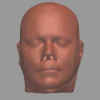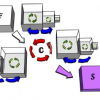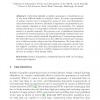74 search results - page 11 / 15 » Representation and Optimal Recognition of Human Activities |
CVPR
2007
IEEE
14 years 9 months ago
2007
IEEE
The ability to determine the identity of a skull found at a crime scene is of critical importance to the law enforcement community. Traditional clay-based methods attempt to recon...
CVPR
2009
IEEE
15 years 2 months ago
2009
IEEE
Several spatiotemporal feature point detectors have been recently used in video analysis for action recognition. Feature points are detected using a number of measures, namely sali...
ROBOCUP
2007
Springer
14 years 1 months ago
2007
Springer
According to the expert literature on (human) soccer, e.g., the tactical behavior of a soccer team should differ significantly with respect to the tactics and strategy of the oppo...
SSPR
2010
Springer
13 years 6 months ago
2010
Springer
Delivering digitally a realistic appearance of materials is one of the most difficult tasks of computer vision. Accurate representation of surface texture can be obtained by means ...
ICML
2004
IEEE
14 years 8 months ago
2004
IEEE
Many difficult visual perception problems, like 3D human motion estimation, can be formulated in terms of inference using complex generative models, defined over high-dimensional ...



